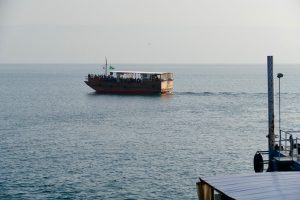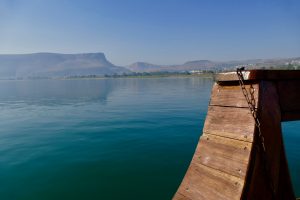Balancing Grace and Glory, Prayer and Ministry
(Acts 6:1-6; Ps 33; Jn 6:16-21
*************************************************
“After feeding the crowd…” Jesus walks on water. In modern terms, the disciples are experiencing a “double whammy” – two miracles back-to-back. We can try to imagine what they were thinking and feeling, but more important what these two miracles are intended to teach us.
The New Interpreters Bible commentary on the gospel offers us the idea of balancing grace and glory in our lives, as Jesus did. The first reading adds the dimension of balancing faith and works, prayer and ministry.
First, Jesus is more than an earthly ruler; he is Lord of creation. Walking on water is an expression of divinity. In Matthew, Mark and John, this miracle is linked with the feeding miracles. This suggests that the two stories were linked in oral tradition as a pair of Galilean miracles. In John, however, the focus is more on the disciples’ experience, allowing the reader to share in that experience.
Jesus’ words in v. 20 are the key to understanding the miracle. The words “ego eimi, do not be afraid” are found in all three accounts. As Jesus walks across the water, he identifies himself to the disciples with the divine name by which God identified God’s self to Moses. The fourth Evangelist portrays Jesus as speaking the way Yahweh speaks in Second Isaiah. They are the words of the salvation oracle, words of comfort spoken to end the distress of God’s people. They confirm that Jesus walking on the water is a theophany and that this manifestation of the divine is the source of the disciples’ fear.

The sudden sea crossing (“immediately the boat reached the land toward which they were going”) is a second miracle. Jesus provided safe passage for the disciples. This too is theophonic, because God provides safe passage to those in distress, as God did for the Chosen people escaping from Egypt. The Fourth Gospel does not narrate the stilling of the storm because it is not a nature miracle, it is a miracle of theophany, of the revelation of the divine in Jesus. The theophonic focus of this narrative is confirmed by the density of the Old Testament allusions to God’s power over water that is a symbol of God’s sovereignty and care. In John, that symbolism applies to Jesus, who shares in God’s works and identity.

Boat on the Sea of Galilee
These two miracles, the feeding and walking on water, present two vivid enactments of the revelation of God’s grace and glory in Jesus, in response to familiar human needs for food and for safe passage. The fears and needs that Jesus’ miracles meet belong to the common fund of human experience. Jesus has gifts and resources to meet the full range of human needs.

Sea of Galilee view from boat
The crowd’s reaction to the multiplication of the loaves (“they were about to come and take him by force to make him king”), however, shows how difficult it is to receive Jesus’ gifts on their own terms and not translate them into our own categories. Jesus’ gift of food and the offer of his grace provided the crowd with a glimpse of his identity, but they immediately tried to twist that identity to serve their own purposes. To make Jesus king is to take his grace and twist it to conform to pre-existent systems of power and authority. To make Jesus king is to judge him according to human glory rather than to see in him God’s glory.
When Jesus withdrew from the crowd, he showed he would offer his gift of grace without claiming worldly power. In that moment his glory was revealed, because true glory has nothing to do with worldly power. In the light of the peoples’ desire to make him king, Jesus’ walking on water provides a true picture of his glory. Jesus reveals himself to the disciples as one with God, sharing in God’s actions, identifying himself with God’s name, speaking God’s words. Yet this is not bravura, nor glory for the sake of glory, but a moment of glory for the sake of grace. Jesus reveals himself to his disciples in order to allay their fears, to ensure their safe passage, to remind them God has been, is and will be their rescue. Jesus’ glory is not revealed for power, but for grace-filled pastoral care.
These stories show the balance between grace and glory. Jesus will not allow his grace to be controlled by the crowd’s desire for glory, and so he hides himself. But he will not hold back his glory from those in need, because this is his mission: to make God known. How believers hold the grace and glory of Jesus in balance is critical to the life of faith. The grace is destroyed if one tries to harness it for false power and authority, and the glory is lost if one does not recognize its presence in the quiet places of Jesus’ grace. Both the grace and the glory are essential to God’s revelation in Jesus.
The first reading adds the theme of balancing prayer and ministry to this reflection. The apostles primary focus was to pray and ponder God’s word, yet they did not want to neglect the more practical needs of the community, so they were inspired by the Holy Spirit to choose seven holy men to meet those needs – the beginning of the deaconate.
Jesus of course is our first model of that fine balance of prayer and ministry – after feeding the crowds, he withdrew to the mountain by himself to pray, to commune with the Father in contemplative prayer, to replenish his spirit. If he felt the need to do this, how much more so should we be desiring to waste time with God in contemplative prayer. That is where deep healing and transformation can take place, because the Word of God is alive and active, penetrating between the marrow and the bone, and the Spirit of God can bring about healing, especially of our fear, at a deeper level than is possible with the best of counselling and therapy. Actually, Thomas Keating calls contemplative prayer “divine therapy.”
In my first mission of Beauval, a local artist had painted on a piece of plywood attached to two poles in the yard near the Church, a large scene of Jesus walking on the water with the words, “It is I, be not afraid” written on it. That artistic rendition of today’s gospel was something I saw every day for over a decade. I believe it gave me strength, even unconsciously, to meet the storms that came to me over those years.
The Eucharist is Jesus feeding us and nourishing us, not with manna and quail, but by his Word and his very body and blood. We who participate with faith are forgiven, healed and empowered to overcome our fear and proclaim to the whole world the Good News of Jesus, Emmanuel, God with us, now risen from the dead and pouring his very own Spirit into us.




Well, thanks for the inspiring message and teachings about having miracles and how it works if we remain faithful and true to the Lord Jesus Christ. Once we receive the communion Jesus is with us no matter what we do and where we are as long as we believe Jesus Christ . God does all the works and miracles on Jesus when he was born and preaching the word and helping the needy. God also instructed certain people to help spread the word and teach people in his name . Yes the Holy Spirit is God and Jesus Christ once he is risen from the dead and pour his spirit on to us . That is why some people have experience with God and the Holy Spirit because they were chosen by God. Jesus is the one with many miracles. Many Blessings !
You have good photos and pictures that relates strongly to the Bible . Jesus walking on water is a miracle . Blessed! Thanks Bishop Lavoie.